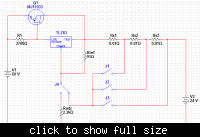Sajjadkhan
Full Member level 5

- Joined
- Sep 25, 2010
- Messages
- 307
- Helped
- 17
- Reputation
- 34
- Reaction score
- 16
- Trophy points
- 1,298
- Location
- Rawalpindi,Pakistan
- Activity points
- 4,199
DONE: I have build an Efficient Sealed Lead Acid battery charger which can charger 200AH battery in less than 5 hrs. Its a micro controller based. It provide constant current as a first phase (constant current ~= battery AH rating) till the voltage reaches to 13.8v then in second phase voltage is doped to 14.4v and finally charger enter into standby mode.
Change i wana:
Since the charger is being commercially used, i want to modify it in such a way that it can connect minimum of 5 batteries and max of 10 batteries. So if one battery is charged it switches to the next one.......
Problem:
As there would be multiple batteries so there AH rating can be different and the charger needs to know the AH rating of the battery for its first phase.How to determine battery AH rating using some circuitry or etc.... any help will be appreciated.
Change i wana:
Since the charger is being commercially used, i want to modify it in such a way that it can connect minimum of 5 batteries and max of 10 batteries. So if one battery is charged it switches to the next one.......
Problem:
As there would be multiple batteries so there AH rating can be different and the charger needs to know the AH rating of the battery for its first phase.How to determine battery AH rating using some circuitry or etc.... any help will be appreciated.





